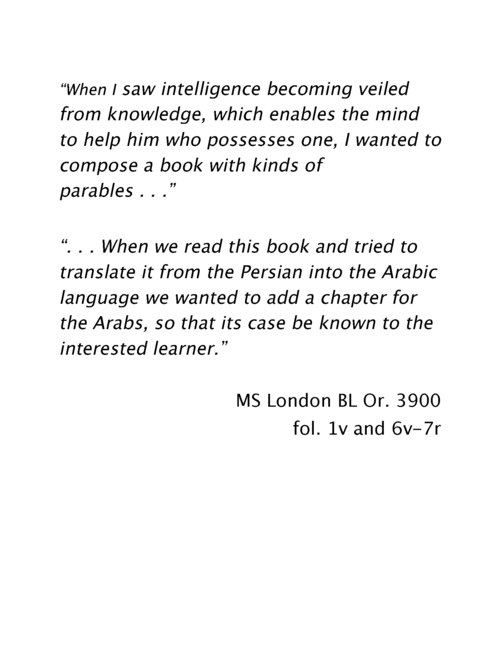Anonymous
Prof. Dr. Beatrice Gründler
Who was the author or the authors of Kalila and Dimna? The question of authorship is indeed an intriguing one. Kalīla and Dimna, it is true, belongs to a broad group of translations from Sanskrit (via Middle Persian) to Arabic of works that had been transmitted orally over centuries and have no known authors. Though the Middle Persian version in which these Indian selections were combined with other texts, is ascribed to a certain Burzoy, himself a character in the book’s prefaces, he is otherwise unattested. Only the Arabic translation and redaction can be safely credited to an identifiable historical person, Ibn al-Muqaffaʿ (d. 757). The subsequent Arabic versions, however, underwent many changes that indicate the agency of many anonymous co-authors.
Ibn al-Muqaffaʿ was famed as a translator of Middle Persian and probably of Greek works and was celebrated as a pioneer of elegant Arabic prose. His writings became models of the emerging adab literature, a bundle of genres that aimed at simultaneously entertaining and educating.
His exact version, however, does not survive, and from the next five centuries, no complete witness of the Arabic text survives—only translations into other languages, beginning with the eleventh century, which gives only an indirect impression of the Arabic models used.
Meanwhile, Arabic sources that refer to the book soon change from calling it Kalīla and Dimna to The Book of the Indians (Kitāb al-Hind). The person some manuscripts now name as author is the philosopher of the frame tale, Baydabāʾ (in European versions he becomes Bidpay).
Complete Arabic manuscripts surface in the thirteenth century, but they vary too drastically (including the sequence of chapters and the internal structure of some of them) to be reduced to one version. Some preserve in their colophons the name of a copyist. Many are damaged, lacking the beginning and the end, which would contain such information. At the same time, copyists added tables of content, and further text before and after the actual work (incipit and explicit). Within the chapters, the text fluctuates substantially, receiving added details, the language and things of daily life are actualized and so forth, changes that have only begun to be surveyed in the project.
It is clear that the text is being retooled, and many manuscripts show a “personal style,” even though the actual person may remain unknown, whether by choice or by the ravages of time. One can say that Ibn al-Muqaffaʿ was collectively overwritten by anonymous copyist-redactors. As a case in point, the master redactor of MS Paris BnF arabe 5881, who cross-copied from a number of Vorlagen and rewrote some chapters, rendering them more dramatic, only dates his work (1681) but does not give his name.
Another interesting case is that of MS London BL Or. 3900. Here, the copyist declares himself to be the author (suppressing Ibn al-Muqaffaʿ altogether): “When I saw intelligence becoming veiled from knowledge, which enables the mind to help him who possesses one, I wanted to compose a book with kinds of parables, so that he who is apt to learn from analogies may act according to their hidden meaning and according to the actions of great men.” This portion is drastically shortened and rewritten from a descendant of MS Riadh 2536 (to which the following passages are very close). At the end of this preface (which was once Ibn-Muqaffaʿ’s), the copyist again steps into his voice, this time as a translator. But by then he has switched his Vorlage. This portion is now copied from a descendant of MS Pococke 400: “When we read this book and tried to translate it from the Persian into the Arabic language we wanted to add a chapter for the Arabs so that its case be known to the interested learner.”
By now, Ibn al-Muqaffaʿ has been effectively replaced by the anonymous copyist-redactor.
